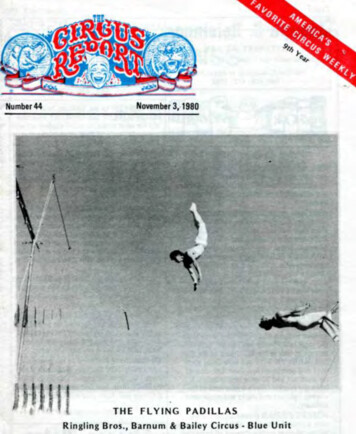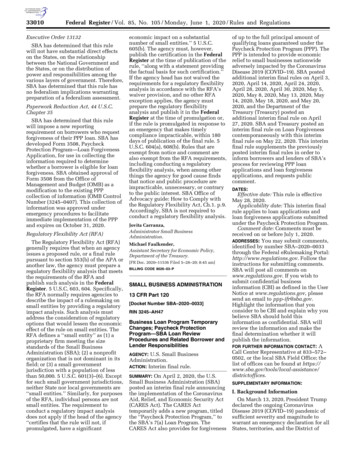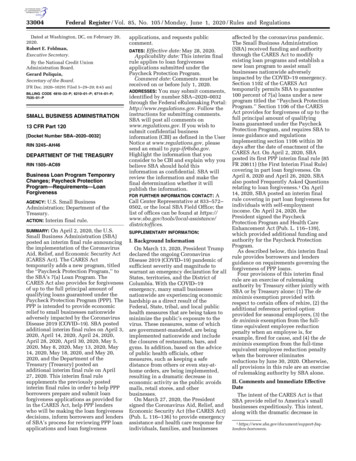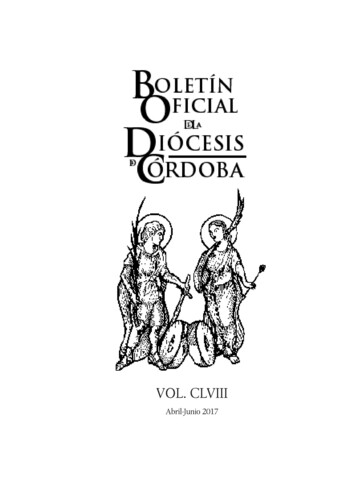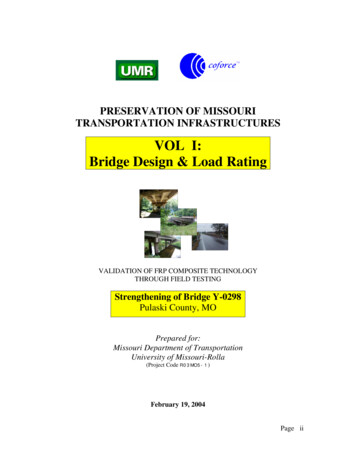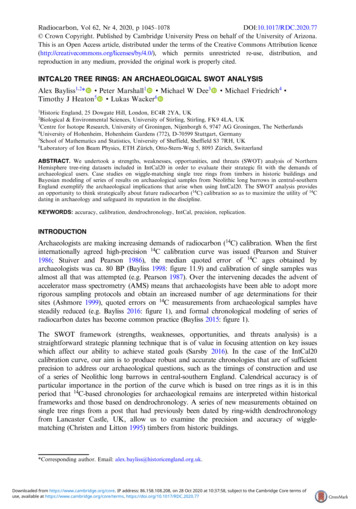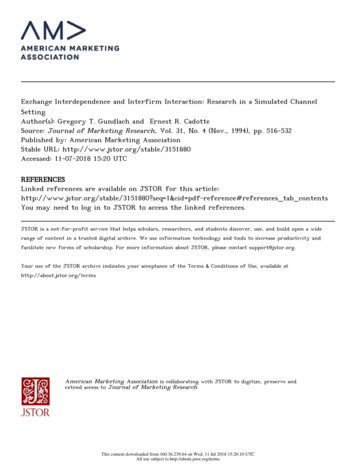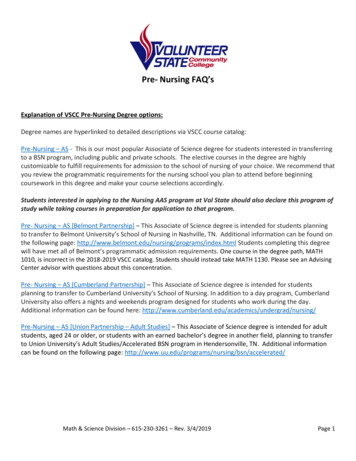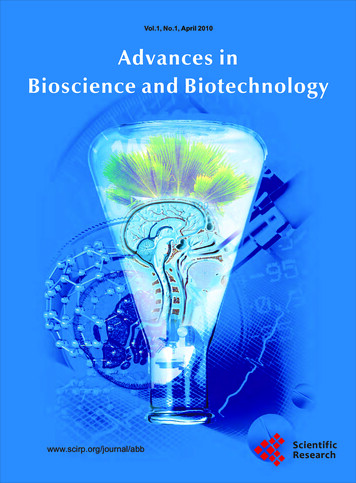
Transcription
Vol.1, No.1, April 2010Advances inBioscience and search
Journal Editorial BoardHh ttp://www.s ci rp.org/journal/ abbEditor-in-ChiefProf. Jinfu WangZhejiang University, ChinaEditorial BoardProf. Suleyman I. AllakhverdievProf. Robert ArmonProf. Bendicho-Hernández CarlosProf. Mohamed ChahineProf. Wenyaw ChanDr. Alexandre Benoît CorthayDr. Robert A. DrewellDr. Mehrnaz Gharaee- KermaniDr. Zhiguo HeDr. Jane L. Hoover-PlowProf. Xing-Jiu HuangDr. Sabzali A. JavadovDr. Lukasz KedzierskiProf. Hari K. KoulDr. Yantao LiProf. Manuela Martins-GreenProf. J. Michael MathisDr. Bouzid MenaaProf. Subhash C. MojumdarProf. Simon Geir MøllerDr. Snæbjörn PálssonDr. David PimentelDr. Pavol ProkopDr. Paul ShapiroDr. Ajay SinghDr. Chuan-He TangProf. John Edward TerrellDr. Jinrong WanRussian Academy of Sciences, RussiaTechnion - Israel Institute of Technology, IsraelUniversity of Vigo, SpainLaval University, CanadaUT Health Science Center at Houston, USAUniversity of Oslo, NorwayHarvey Mudd College, CanadaUniversity of Michigan, USACentral South University, ChinaCase University, USAChinese Academy of Sciences, ChinaUniversity of Puerto Rico, CanadaWalter and Eliza Hall Institute of Medical Research, AustraliaUniversity of Colorado Denver School Of Medicine, USAArizona State University, USAUniversity of California, USALouisiana State University, USAFluorotronics, Inc., USAUniversity of New Brunswick, CanadaUniversity of Stavanger, NorwayUniversity of Iceland, IcelandCornell University, USATrnava University, SlovakUniversity of Maryland, USALystek International Inc., CanadaSouth China University of Technology, ChinaField Museum of Natural History, USAUniversity of Missouri, USAEditorial AssistantsShirley S ongScientific Research Publishing. Email: abb@scirp.org
ABBVol.1, No.1, 1-59 (2010)TABLE OF CONTENTSVolume 1, Number 1, April 2010The effects of neem [Azadirachta indica A. Juss (meliaceae)] oil on Fusarium oxysporum f. sp.medicagenis and Fusarium subglutinans and the production of fusaric acid toxinM. R . F. G eraldo, C . C. A rroteia, C. K emmelmeier 1The effect of L-ornithine hydrochloride ingestion on human growth hormone secretionafter strength trainingS. Demura, T. Yamada, S. Yamaji, M. Komatsu, K. Morishita 7On the orientation of plane tensegrity cytoskeletons under biaxial substrate stretchingA. P. Piren tis, K. A. Lazopou los 12Effect of intraperitoneal and intramuscular injection of killed aeromonas hydrophila onlymphocytes and serum proteins of common carp, cyprinus carpioR. Peyghan, G. H. Khadjeh, N. Mozarmnia, M. Dadar 26Biomass and productivity in sal and miscellaneous forests of Satpura plateau (Madhya Pradesh) IndiaP. K . P ande, A . K . P atra 30Osmolyte modulated enhanced rice leaf catalase activity under salt-stressS. Sahu, P. Das, M. Ray, S. C. Sabat 39Growth rate data fitting of Yarrowia lipolytica NCIM 3589 using logistic equationand artificial neural networksS. B. Imandi, S. K. Karan am, S. Darsipudi, H. R . Garapati 47Applications of exponential decay and geometric series in effective medicine dosageC. A nnamalai 51A comparative investigation of interaction between metal ions with L-methionene and relatedcompounds such as alanine, leucine, valine, and glycine in aqueous solutionS. A . A . S ajadi 55Copyright 2010 SciRes.Openly accessible at http://www.scirp.org/journal/ABB/
Advances in Bioscience and Biotechnology (ABB)Journal InformationSUBSCRIPTIONSThe Advances in Bioscience and Biotechnology (Online at Scientific Research Publishing, www.SciRP.org) is published monthly byScientific Research Publishing, Inc., USA.Subscription rates:Print: 50 per issue.To subscribe, please contact Journals Subscriptions Department, E-mail: sub@scirp.orgSERVICESAdvertisementsAdvertisement Sales Department, E-mail: service@scirp.orgReprints (minimum quantity 100 copies)Reprints Co-ordinator, Scientific Research Publishing, Inc., USA.E-mail: sub@scirp.orgCOPYRIGHTCopyright 2010 Scientific Research Publishing, Inc.All Rights Reserved. No part of this publication may be reproduced, stored in a retrieval system, or transmitted, in any form or byany means, electronic, mechanical, photocopying, recording, scanning or otherwise, except as described below, without thepermission in writing of the Publisher.Copying of articles is not permitted except for personal and internal use, to the extent permitted by national copyright law, or underthe terms of a license issued by the national Reproduction Rights Organization.Requests for permission for other kinds of copying, such as copying for general distribution, for advertising or promotional purposes,for creating new collective works or for resale, and other enquiries should be addressed to the Publisher.Statements and opinions expressed in the articles and communications are those of the individual contributors and not the statementsand opinion of Scientific Research Publishing, Inc. We assumes no responsibility or liability for any damage or injury to persons orproperty arising out of the use of any materials, instructions, methods or ideas contained herein. We expressly disclaim any impliedwarranties of merchantability or fitness for a particular purpose. If expert assistance is required, the services of a competentprofessional person should be sought.PRODUCTION INFORMATIONFor manuscripts that have been accepted for publication, please contact:E-mail: abb@scirp.org
Advances in Bioscience and Biotechnology, 2010, 1, 1-6ABBdoi:10.4236/abb.2010.11001 Published Online April 2010 (http://www.SciRP.org/journal/abb/).The effects of neem [Azadirachta indica A. Juss (meliaceae)] oilon Fusarium oxysporum f. sp. medicagenis and Fusariumsubglutinans and the production of fusaric acid toxinMarcia Regina Ferreira Geraldo1, Carla Cristina Arroteia2, Carlos Kemmelmeier2,*1Universidade Tecnológica Federal do Paraná, Campo Mourão, Brazil;Departamento de Bioquímica, Universidade Estadual de Maringá, Avenida Colombo, Maringá, Brazil.Email: ccarroteia@uem.br; ckemmelmeier@uem.br; mperdoncini@ibest.com.br2Received 25 February 2010; revised 8 March 2010; accepted 10 March 2010.ABSTRACTFungi of the genus Fusarium are well known plantpathogens, cause several vascular diseases and areproducers of toxins. In vitro assays evaluated the effects of Neem (Azadirachta indica) oil on the diameterof colonies, dry weight, spore production, spore viability and production of Fusaric Acid toxin on Fusarium oxysporum f. sp. medicagenis and Fusariumsubglutinans isolates. Effects of Neem oil were analyzed at concentrations 0.25%, 0.5% and 1% inCzapek Yeast Agar medium. The production of Fusaric acid was determined by Thin Layer Chromatography and quantified by UV spectrophotometry.Neem oil showed inhibitory effects on the isolatestested, although they varied according to type of isolate and oil concentration. Neem oil was efficient inreducing the colonies’ diameter and dry weight inconcentration-dependent manner. Neem oil was efficacious at higher concentration in the decrease ofsporulation. Spore germination was affected by Neemoil when the spore was grown in Neem-containedmedium as when the spore emerged from a culture ina Neem medium. Neem oil decreased and even inhibited the production of Fusaric acid by the assayedisolates. Since these isolates are plant pathogens andproducers of Fusaric acid, Neem oil may be introduced as an integral item in the management of hostplants.Keywords: Fusarium; Azadirachta Indica; Fusaric Acid;Antifungal Activity1. INTRODUCTIONFungi of the genus Fusarium, known to be plant pathogens causing several vascular diseases, are largely distributed in soils, especially cultivated ones, and are active during the decomposition of cellulose material [1].Fusarium spp. is the main colonizer of pre-harvest cerealgrains, even though it may also occur in grain storage,especially under high humidity conditions [2]. Fusariumoxysporum f. sp. medicagenis is a important pathogenfor alfafa (Medicago sativa L.), whereas Fusariummoniliforme f. sp. subglutinans Fusarium subglutinans [3,4] is a pathogen for maize, sugarcane and othergrasses.The above mentioned fungi are producers ofmycotoxins with special reference to fusaric acid (5butylpicolinic acid), which has a hypotension effect inseveral animals due to an increase in dopamine in thebrain and to other peripheral effects in the tryptophanmetabolism [5,6]. It not only interferes with animal foodconsumption, but also increases the toxicity of othermycotoxins [7]. Expectedly, the mycotoxin is rarelyfound alone in Fusarium-contaminated grains. This factincreases its importance in mycotoxicoses since thiscondition heightens the Fusaric acid’s interactivity withother toxins, such as fumonisins and moniliformin [8,9].Fusaric acid was one of the first fungus metabolites isolated from plants with Fusarium wilt and subsequentlyshown to be involved in the symptoms [9]. It is currentlyknown to cause phytotoxic symptoms in several plantsthat develop Fusarium wilt. There are positive correlations between the production of the compound and thefungus virulence in the host [10]. Studies with severalFusaric acid-treated plants revealed that it inhibited respiratory activities [11-13]; decreased levels of adenosinetriphosphate, increased the release of electrolytes [13],caused changes in the difference of transmembrane electrical potential [14]; disturbed nitrogen metabolism, decreased cell viability and induced apoptosis [12]; inhibited enzyme activities of plant defense [15-17]; inducedplant’s symptoms such as chlorosis, necrosis, inhibitionand lengthening of roots [18,19]; and caused loss ofweight in the plant [20].Inhibiting chemical agents, mainly low molecularweight organic acids used in the preservation of storedgrains [21], have exhibited several problems related toPublished Online April 2010 in SciRes. http://www.scirp.org/journal/abb
2M. R. F. Geraldo et al. / Advances in Bioscience and Biotechnology 1 (2010) 1-6the development of fungus resistance and the emergenceof secondary pests owing to their indiscriminate use [22].This fact has increased risks of high toxic residue levels,which damage the environment and put human and animal health at risk. Plants’ natural extracts may be analternative for the employment of these synthetic antifungal chemical agents since they may be easily acquired and employed, they are low cost and lack theproblems inherent to synthetic chemical products [23].The Neem (Azadirachta indica A. Juss) is a denseleaved tree of the Meliaceae family whose biologicallyactive extracts are obtained from its leaves, seeds, fruitsand trunk, with acknowledged multiple therapeutic, insecticide, nematicide, anti-microbial and fungicide qualities [24-26]. Several studies show that Neem water andoil extracts are toxic to fungi [27-31] and may result inthe reduction or inhibition of mycotoxin production[32-36]. Great interest exists in verifying the effects ofthe plant’s extract on the fungi Fusarium oxysporum f.sp. medicagenis and Fusarium subglutinans, due to thefact that if there is an inhibitory activity, the extract maybe tested in host plants for the control of this pathogen.This is the main purpose of the present study.2. MATERIAL AND METHODS2.1. Neem OilNeem Oil (NO) was commercial product (BioNeem )extracted from the seeds of the neem plant.2.2. Fungal IsolatesIsolates of Fusarium oxysporum f. sp. medicagenis UnB201 and Fusarium subglutinans UnB 335 and UnB 327were the test organisms used. They were stored in PotatoDextrose Agar (PDA) of the fungus collection at theLaboratory of Chemistry and Physiology of Microorganisms of the Biochemistry Department, State University of Maringá. Maringá. PR Brazil.2.3. Effects of NO on the Colony Diameter, DryWeight, Sporulation and Spore ViabilityAssays were carried out according to technique described by Marques et al. [37]. Culture media employed wereMalt Extract Agar (MEA) and Czapek Yeast Agar (CYA)[38]. CYA was prepared by adding NO to the medium toobtain concentrations of 0.25%, 0.5% and 1%, whichwere the test media. CYA without NO was the controlmedium. Isolates were pre-incubated in MEA duringfour days, at 25ºC. Plugs were retrieved from thesecolonies by a 5 mm-sterilized metallic ring and inoculated in 95 mm-Petri dishes with media control CYA(without NO) and with CYA tests (with NO at concentrations 0.25%, 0.5% and 1.0%).Isolates were inoculated in media CYA control andtests at 25ºC, during seven days, to verify colonies’ diCopyright 2010 SciRes.ameter. Colony’s diameter was determined by measuringtwo diameters, in mm, of each colony on the seventh dayof incubation.Dry weight was determined after seven days of incubation of isolates, at 25ºC, in media CYA control andtests. Media were liquefied and mycelium was retrievedby a pincer and placed on a weighted filter paper. Paperswith mycelia were dried at 70ºC. After 72 h, they wereweighted daily until completely dried.Spores production was evaluated by placing 10 mL ofa 1:1 mixture consisting of a sterilized solution NaCl(0.89%, w/v) and Tween 80 (0.1%, v/v), on the incubated mycelium, after 7 days, at 25ºC, in media CYAcontrol and tests. After spores were removed by scrapingall the mycelia, they were transferred to a test tube andcounted under a microscope in a Neubauer chamber.Dilution of suspension was employed when required.Results were given in spores/mm2 of colony. Spores viability (germination) was evaluated by their cultivationin cellophane membranes, previously cut 2 cm 2 cmsize, dipped in distilled water in an Erlenmeyer flask andsterilized. Two situations were employed to verify sporeviability: Experiment 1 - membranes were placed inCYA plates; each plate had one of the Neem oil concentrations mentioned above; they were then inoculatedwith spore suspensions from grown colonies in CYAwithout Neem oil, after incubation for four days, at 25ºC; Experiment 2 - membranes were placed in plateswith medium CYA without Neem oil. Inoculation wasundertaken with spore suspensions from colonies grownin CYA with one of the different Neem oil concentrationmentioned above, after incubation during four days, at25ºC. Assays were undertaken by inoculating 0.1 mL offungus suspension with 105 spores mL-1 on each membrane. Plates with incubated membranes were then incubated at 25ºC, in the dark, during 15 h. Drops of lactophenol cotton blue staining were then placed on grownmembranes to impair germination and facilitate visualization of spores. By 400 microscope, 150 spores ineach area of the lamina were counted. Germinated andnon-germinated spores were counted and germinationpercentage established.2.4. Effects of Neem Oil on the Production ofFusaric Acid (FA)Assay was undertaken according to technique describedby Eged [39]. Isolates were previously cultivated inMEA at 25ºC. After a four-day incubation, 5 mm diameter plugs of the culture were transferred to Petri plateswith CYA control (without Neem oil extract) and tests(with 0.25%, 0.5%, 1.0% of Neem oil) and cultivated,during 7 days, within the same conditions. Media wereliquefied after incubation and mycelia removed with apincer. Liquefied medium was employed to extract FAsince the mycotoxin is deposited in the extracellular meABB
M. R. F. Geraldo et al. / Advances in Bioscience and Biotechnology 1 (2010) 1-6dium by the fungus.2.5. Extraction and Quantification of FAHydrochloric acid at 2N was added to the medium toreadjust pH to 3.9 - 4.0. Further, FA was extracted thricewith 30 mL of ethyl acetate in a separation funnel. Thethree extracts were put together and evaporated in a rotating evaporator at 50ºC, until complete dried. Residuewas re-suspended in a 3 mL ethanol 80% water solution.2.6. Detection and Quantification of FA by ThinLayer Chromatography (TLC), and UVSpectrophotometryBasically the procedure described by Eged [39] was followed. In the case of TLC, 20 20 cm aluminium plates(Alugram , Macherey-Nagel), coated with silica gel 60(fluorescence indicator UV254) were employed. Plateswere first dipped in a chromatography development solution (n-butanol : acetic acid : ethyl acetate : water3:2:2:2 v/v), dried and activated at 80ºC during 5-7 minutes. Further, 5-10 μL of the standard solution ofFusaric acid 0.2% (Acros Organics ) and 30 μL of thefungus residue extract solution were spotted on the activated TLC plate. After development (Rf 0.58 - 0.60),the plates were dried and observed under a 254 nm UVlight. Sites with FA were cut from the plate and eludedwith 3 mL ethanol liquid solution 80% (UV grade) during one hour. The contents of the FA in each samplewere then determined by spectrophotometry (λ 270 nmabsorbance - UV-VIS spectrophotometer Shimadzu mini1240, Japan).Quantification of FA was undertaken according tostandard calibration of FA (1 g Fusaric acid / 10 mL distilled water). Resulting quantity of FA was calculatedaccording to the quantity of sample applied in the TLCplate in µg FA per gram of mycelial dry weight. All described experiments were carried out four times. Treatment results were evaluated statistically by one-wayvariance analysis (ANOVA), probability 1% (p 0.01);in the case of significant difference, means were analyzed by Tukey’s test (p 0.05), with the statistical program SAS (Statistical Analysis System. Sas Institute Inc.,Cary, NC, USA, 2001).3. RESULTS AND DISCUSSIONThe effects of Neem Oil (NO) on the tested Fusariumisolates varied according to the isolate and NO concentrations (Table 1).Neem oil was efficacious in reducing the diameter anddry weight in a concentration-dependent manner. Reduction of colonies’ diameter occurred in all isolates: reduction was highest according to increase in oil concentration. In isolates 335a and 327, NO reduced the dryCopyright 2010 SciRes.3weight at the lowest concentration (0.25%). As NO concentration increased, the reduction of dry weight increased. Dry weight reduction in isolate 201 was effective in concentrations 0.5% and 1% of NO (Table 1).NO at higher concentrations was efficient in sporulation decrease. The number of spores in isolates 201 and335a were lower only in an oil concentration of 1%, butonly statistically significant only for the isolate 327. Anincrease in sporulation occurred at lower concentrations.Sporulation of isolate 327 was reduced as from oil concentrations at 0.5% (Table 1).When spores were collected in colonies grown in aNO-less medium and germinated in a medium with different oil concentrations (Table 1-VS 1), germination ofspores was significantly influenced only in concentration1%. Isolate 335a had its germination affected as from oilconcentration 0.5%. On the other hand, when sporesobtained from media with different Neem concentrationsand germinated in NO-less medium (Table 1-VS 2),spore viability was not affected in isolate 327, which didnot differ significantly from control. There was a decrease in spore viability in isolate 335a at all concentrations. This fact shows that spore germination is isolate-dependent and may be affected by NO either whenthe spore is grown in a medium with Neem or when thespore emerges in a medium with Neem. However, in thecontext of isolates tested in current assay (Table 1), theisolate 201 had the highest germination susceptibly toNO.The production of Fusaric acid (FA) by the isolates(Table 1) was affected by NO Neem oil significantlyreduced the production of FA, in proportion to oil concentration increase at all concentrations tested in isolate327. Fusaric acid failed to be detected either in concentration 1% for isolate 327 or in all concentrations forisolate 335a. The latter, however, produced th
of secondary pests owing to their indiscriminate use [22]. This fact has increased risks of high toxic residue levels, which damage the environment and put human and ani-mal health at risk. Plants’ natural extracts may be an alternative for the employment of these synthetic

